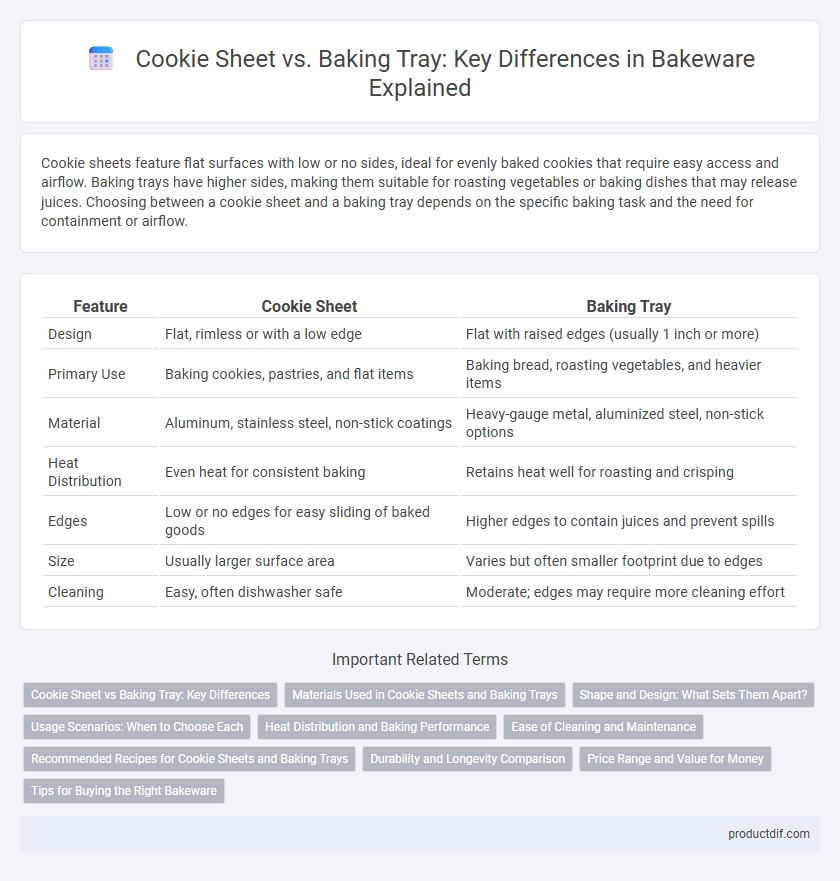Cookie sheets feature flat surfaces with low or no sides, ideal for evenly baked cookies that require easy access and airflow. Baking trays have higher sides, making them suitable for roasting vegetables or baking dishes that may release juices. Choosing between a cookie sheet and a baking tray depends on the specific baking task and the need for containment or airflow.
Table of Comparison
| Feature | Cookie Sheet | Baking Tray |
|---|---|---|
| Design | Flat, rimless or with a low edge | Flat with raised edges (usually 1 inch or more) |
| Primary Use | Baking cookies, pastries, and flat items | Baking bread, roasting vegetables, and heavier items |
| Material | Aluminum, stainless steel, non-stick coatings | Heavy-gauge metal, aluminized steel, non-stick options |
| Heat Distribution | Even heat for consistent baking | Retains heat well for roasting and crisping |
| Edges | Low or no edges for easy sliding of baked goods | Higher edges to contain juices and prevent spills |
| Size | Usually larger surface area | Varies but often smaller footprint due to edges |
| Cleaning | Easy, often dishwasher safe | Moderate; edges may require more cleaning effort |
Cookie Sheet vs Baking Tray: Key Differences
Cookie sheets feature a flat, rimless design ideal for evenly spaced baking to promote crisp edges, while baking trays have raised edges to contain liquids and support items with batter. The low profile of cookie sheets allows for better airflow and faster heat transfer, making them perfect for cookies and pastries. Baking trays' deeper sides make them suitable for roasting vegetables or meats where juices need to be contained.
Materials Used in Cookie Sheets and Baking Trays
Cookie sheets are commonly made from aluminum or aluminized steel, offering excellent heat conductivity for even baking, while some feature non-stick coatings for easy release of cookies. Baking trays often use heavier gauge steel or cast iron, providing superior heat retention and durability suitable for roasting and baking tasks beyond cookies. Both materials impact baking performance by influencing heat distribution, stick resistance, and cleaning convenience.
Shape and Design: What Sets Them Apart?
Cookie sheets feature a flat surface with low or no sides, allowing cookies to bake evenly and spread without constraints. Baking trays have higher, often rolled edges that contain juices and prevent spillage, making them versatile for roasting and baking tasks. The distinct shapes and edge heights directly influence airflow and heat distribution, tailoring each for specific baking needs.
Usage Scenarios: When to Choose Each
Cookie sheets are ideal for baking cookies and other flat biscuits, providing even heat distribution with their thin, flat surface and low edges that prevent spreading dough from sticking. Baking trays are better suited for roasting vegetables, baking casseroles, or cooking larger food items due to their deeper sides that contain juices and allow easy flipping or stirring. Selecting between a cookie sheet and a baking tray depends on whether the recipe requires flat baking or containment of liquids and larger food portions.
Heat Distribution and Baking Performance
Cookie sheets feature a flat, rimless design that promotes even heat distribution, preventing hot spots and ensuring consistent baking results. Baking trays typically have higher sides that can hinder airflow, potentially leading to uneven heat distribution and longer baking times. For optimal baking performance, cookie sheets are preferred when aiming for crisp, evenly cooked cookies, while baking trays suit recipes requiring containment of liquids or thicker batter.
Ease of Cleaning and Maintenance
Cookie sheets typically feature a flat, rimless design that simplifies cleaning by eliminating corners where dough can accumulate, making maintenance quicker and easier. Baking trays often have raised edges that trap grease and crumbs, requiring more thorough scrubbing and sometimes soaking to remove residue effectively. Non-stick coatings on both types enhance ease of cleaning, but durability varies, with cookie sheets generally sustaining less wear over time due to their simpler shape.
Recommended Recipes for Cookie Sheets and Baking Trays
Cookie sheets excel at baking thin, delicate cookies like sugar cookies and chocolate chip cookies due to their flat surface and low edges that promote even heat distribution and easy removal. Baking trays, with their higher sides, are ideal for roasting vegetables, baking sheet cakes, and preparing dishes that may release juices, such as roasted chicken or casseroles. Selecting the right bakeware enhances recipe outcomes by matching the pan's design to the cooking method and food type.
Durability and Longevity Comparison
Cookie sheets are typically thinner and less durable than baking trays, which are often made from heavier-gauge materials like aluminized steel or cast aluminum, enhancing their longevity. Baking trays resist warping and corrosion better due to their robust construction and often feature non-stick coatings that extend their usable life. Investing in a high-quality baking tray provides long-term durability, making it a more reliable choice for consistent baking performance over time.
Price Range and Value for Money
Cookie sheets typically range from $10 to $30, offering a flat surface ideal for even heat distribution, while baking trays often cost between $15 and $40 due to their higher sides and versatility. In terms of value for money, cookie sheets are perfect for those focused on baking cookies and smaller baked goods efficiently, making them a budget-friendly option. Baking trays provide greater functionality, suitable for roasting and baking larger items, justifying their slightly higher price with enhanced usability.
Tips for Buying the Right Bakeware
When choosing between a cookie sheet and a baking tray, prioritize thickness and material for optimal heat distribution, with heavy-gauge aluminum or stainless steel being ideal for even baking. Look for features like rimmed edges on baking trays to prevent spills, while cookie sheets with flat, rimless designs offer better airflow for crispier cookies. Consider non-stick coatings for easy cleanup, but ensure they are PFOA-free to maintain food safety and bakeware longevity.
Cookie sheet vs Baking tray Infographic

 productdif.com
productdif.com